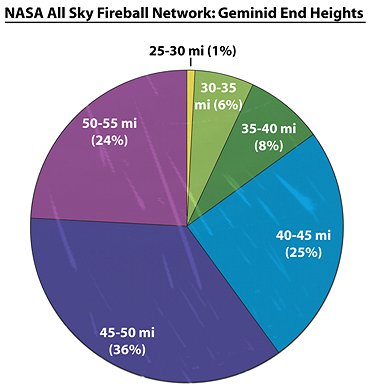Geminids: How Low Do They Go?
The Marshall Meteoroid Environment office put together the plot below showing the distribution of end heights of Geminids seen with our fireball camera network. 85% of Geminids burn up 40 to 55 miles above Earth’s surface and 15% get below 40 miles altitude.
Geminids penetrate deeper into the atmosphere than the Perseids because they are moving slower (78,000 mph for the Geminids compared to 130,000 mph for the Perseids) and are made up of denser material, owing to the fact that the Geminid parent body is rocky asteroid 3200 Phaethon and the Perseid parent is a comet yielding more fragile material.

This video shows meteors captured by a wide-field camera at the NASA Marshall Space Flight Center on the night of December 12. There are 141 events; at least 77 of these are Geminids, based on their angular speed and direction of travel. Near the end of the movie, a couple of satellites are visible crossing the field of view.
For those of us sky watching for meteors , this means we have a good chance of viewing a Geminid meteor. Tonight, December 13, into the early morning of December 14 is the peak. Happy meteor watching!



























